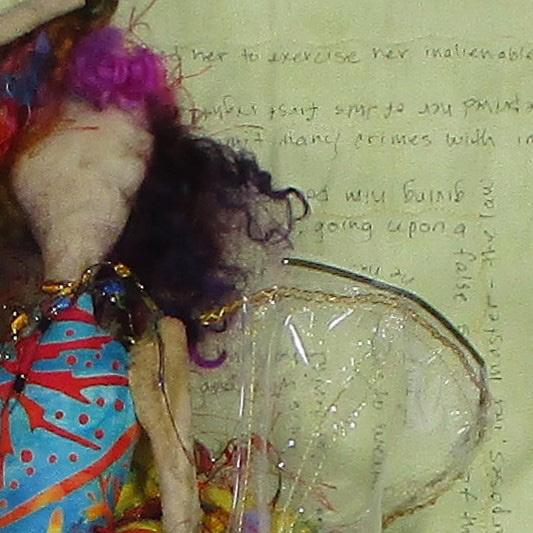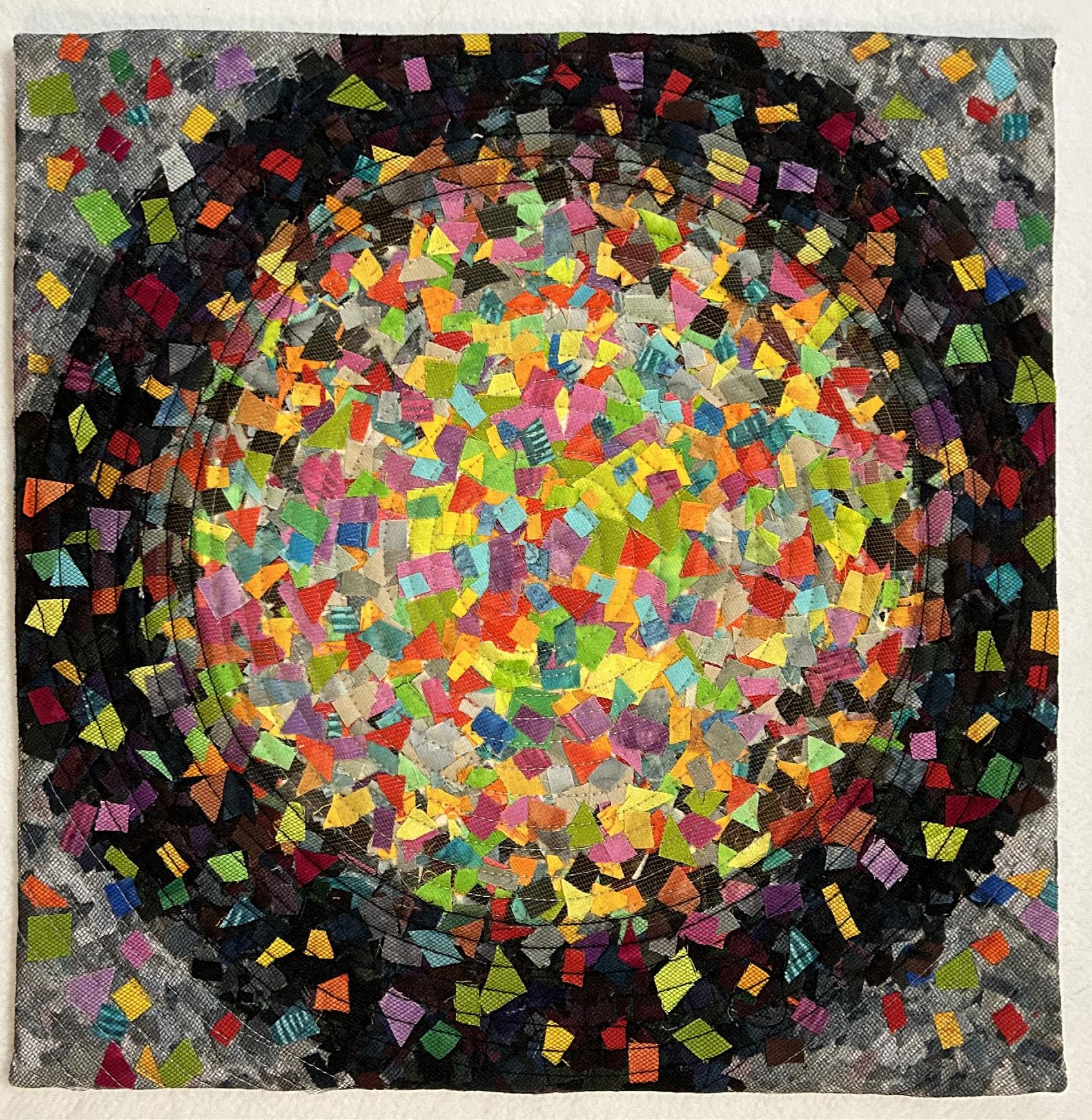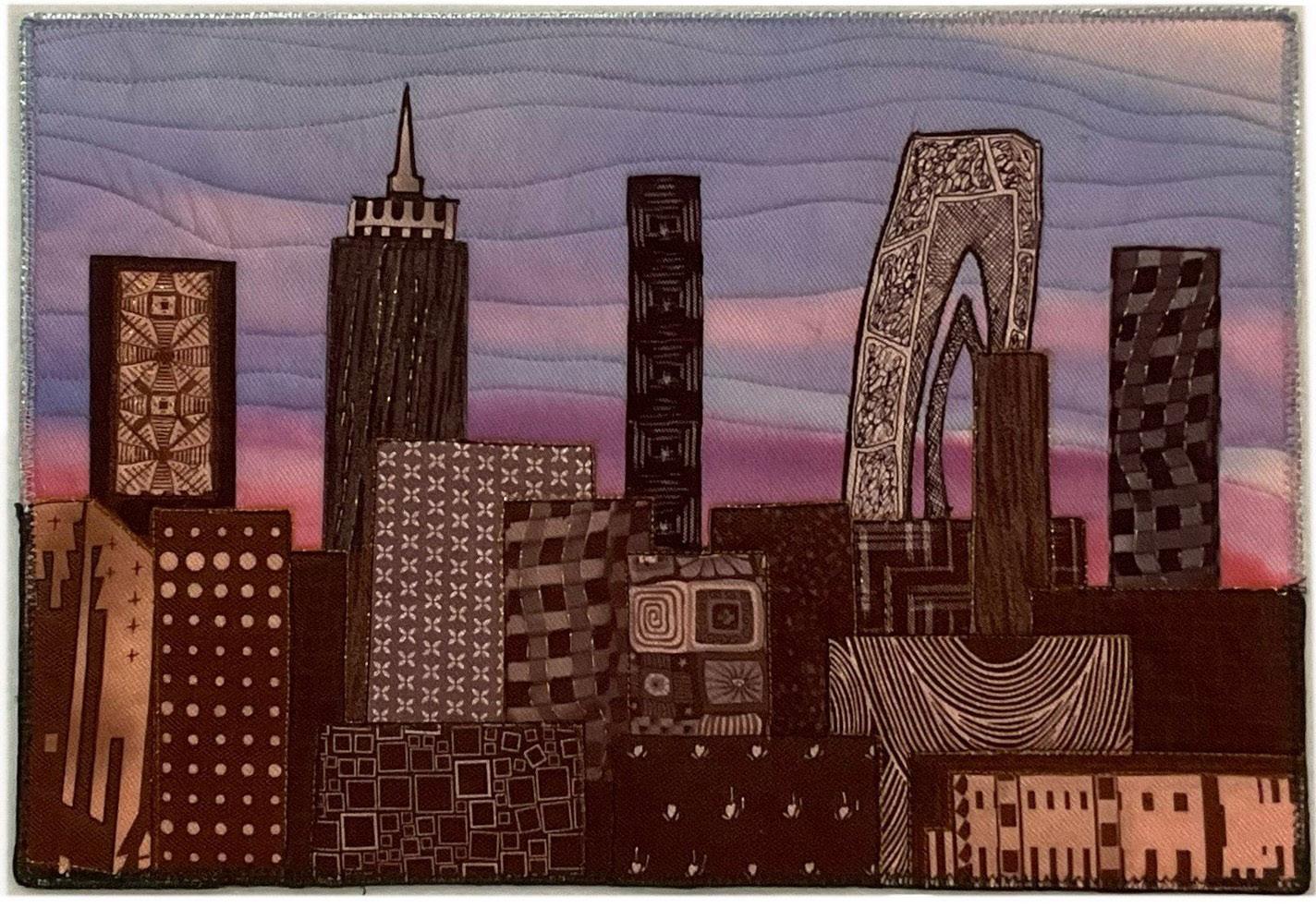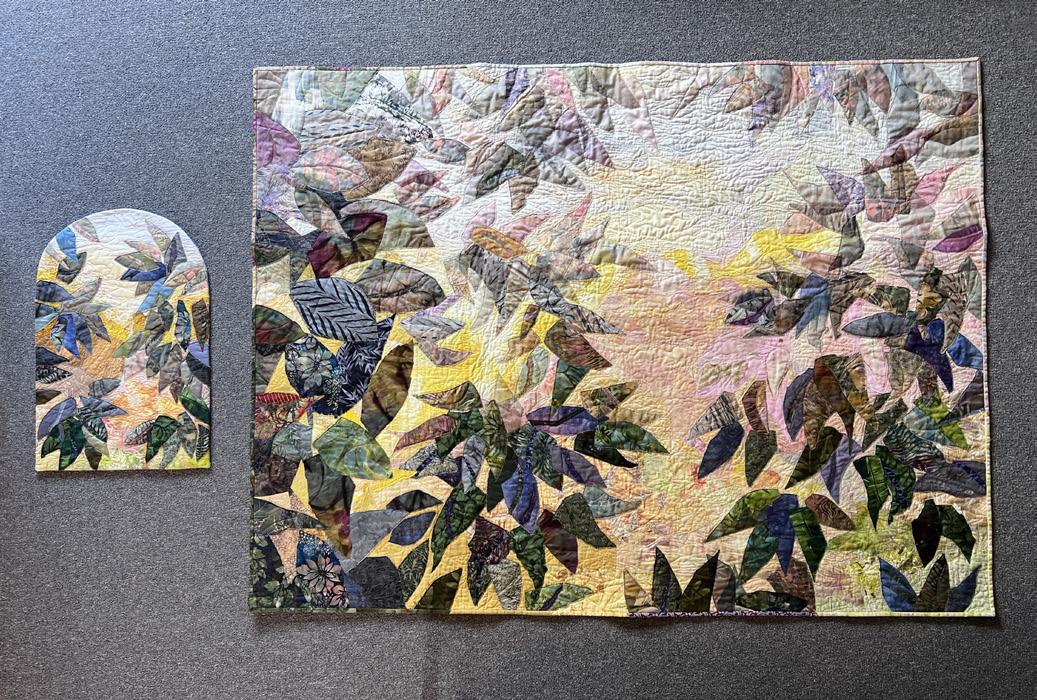














The SAQA NJ + NY region set two quilt art challenges for members during the summer of 2024.
Inspiration at Cornell University:
The Cornell Fashion + Textile Collection houses “more than 10,000 garments, flat textiles, and accessories from the late 18th century to the present.” Some members visited the collection in person earlier in the year, while others explored the collection online. Inspired by an assignment by Catherine Kueffer Blumenkamp, our host and a lecturer in human centered design, member artists were asked to choose three items from the collection that pique their interest. Using these items for inspiration, artists designed and created a new art quilt of any size.


Inspiration working with Scale and Scraps:
Anna Brown’s Canopy 18 Burning #2 (7”x 10”) is in a SAQA Trunk Show, and her Canopy 18 Burning (2020,108”x 39”) appeared in Quilts=Art=Quilts 2024. In discussion with Anna, Linda Stern was inspired to challenge the region to work with the same materials to create pieces of different sizes. Not only does this approach reduce the waste of materials, it also provides design challenges in working within different parameters. Member artists either created a small piece using scraps from a larger art quilt already completed, or created a large art quilt with the textiles already used for a small piece. The quilts are visibly different in size, but there was no size requirement.
Denise Fox, NJ
Gabriele diTota, FL
Jean Gerow, NY
Jean McCreary, NY
LM Noudehou, NY
Suzanne Housley Noonan, RI
Therese O’Connor, NY
Barbara Sferra, NY
Carol Boyer, NY
Cathy Miranker, CA and NY
Chirstine Janove, NY
Denise Giardullo, NY
Giovanna Nicolai, Italy
Judy Gignesi, NY
Linda Stern, NY
Nancy Mirman, NY
Nike Cusumpas, NY
Randy Frost, NY
Tamar Drucker, NY
We would like to thank the artists for providing photos of their inspiration and their art quilts.
We would also like to thank Catherine Kueffer Blumenkamp for the personal tour of let the grain do the work, the exhibition which she curated, and the tour of the Cornell Fashion + Textile Collection (CF+TC). We thank the CF+TC for permission to share the inspiration photos with our members.
See https://cornellfashion.catalogaccess.com.
Editor: LM B. Noudehou


Tumbling Swirls
(2024, 12” × 12”)
Materials include recycled cotton and linen clothing, commercial cotton and silk, Peltex stabilizer, cotton and polyester threads, and cotton cord.
My two inspiration images from the collection are a Chinese woman's robe c. 1900, and the scalloped edge of a shawl c. 1930. From the two inspiration images I created Tumbling Swirls. It was fun looking through the Cornell Collection online, seeing all the textiles from different cultures and eras. I easily found dozens of images that captured my imagination. Ultimately, the bold pink and black color scheme of the robe and the unusual embroidery design of the shawl intrigued me the most, and Tumbling Swirls emerged.

Tumbling Swirls (2024, 12” × 12”)


Break the Ceiling…. ok Kamala!
(2024, 27” h × 22 ½” w)
The swatches of resist indigo dyed adire cloth have a patchwork-like pattern of various geometric and stylized floral motifs, and include ‘OK’ design. Made about 1961 in Nigeria.
The material is cotton, and is machine pieced and quilted. I did not use indigo, but rather Indigo MX Dye with glue resist to create the central panel. The green border is a deconstructed screen print.
I enjoyed looking through the Cornell catalog, but knew that I was looking for something that I would enjoy basing a new piece on. I had recently made a piece using school glue as a resist and then dye painting over it, and liked the effect. I have worked with indigo in the past and thoroughly enjoyed the process. However, with no indigo vat available, I decided to use indigo dye and the glue resist to create my piece based on the image I chose in the catalog. I loved the “OK” in the original and decided to go out on a political limb. I added coconut shapes and coconut trees along with the OK symbol to reference Kamala Harris’s remark, “you think you just fell out of a coconut tree?”

Break the Ceiling…. ok Kamala! (2024, 27” h × 22 ½” w)

This dress was worn by Mrs. Hitchcock “when she and her husband, a world renowned entomologist, were presented at the Court of the Emperor Meiji Tenno of Japan, about 1885.”

(2024, 3D: 18” W, 6” D, 32”H)
Materials include a handmade stuffed cotton doll, wool, felt batting, vinyl, florist wire, coat hanger, cotton batiks, cotton reproduction 1860s fabrics, tulle, cotton and invisible threads.
We have seen hoop skirts, corsets and bustles in movies and read about them in romance novels and the like. Seeing and touching the actual pieces in the collection at Cornell opened my eyes to the amount of energy, resources, and creativity that went into these often single-use garments. However, the garments were made in such a manner to force a woman to be on display only. She couldn’t sit, bend over, run, or breathe hard; they constrained her shape and movements tremendously. What inspired me to create this piece was the realization that this clothing mirrored the legal and cultural norms of the time. Women were hemmed in physically as much as their lack of rights constrained all other areas of their lives. In the background, I have printed a large portion of the 1848 Declaration of Sentiments approved in Seneca Falls to remind the viewer of all the rights the 1860’s woman lacked. I have to believe that within each dress, within each woman, was a free spirit, just yearning to break free and leave all the imposed constraints behind. My piece reflects that belief.


(2024, 14” w × 24”h)
Materials include Batiks and what is called by some fabric sellers, “Amish black cotton.”
The inspiration photo was taken in the teaching collection area at Cornell in Ithaca. What caught my eye was the difference between the costume (ornate and traditionallooking) and the contemporary quilt hanging next to it. Yet the two are connected by the gold dots at the waist and ankles of the costume and in the quilt. I chose to interpret the quilt in a different color scheme and to connect the green dots with handstitched bubbles moving through the capsule shape unified by the border



The Delphos gown of silk and glass (on the left) was designed by Henriette Negrin and Mariano Fortuny about 1930 in Italy.
The black silk, grosgrain ribbon, dress was designed by Chanel in 1938 in France.
The Open Door
(2024, 29”× 43”)
Hand pieced and hand quilted from Kona cotton solids. While walking through the Cornell textile collection, I became fascinated with how pleating is used to add both texture and volume in the making of clothing. In developing the symbolic landscape that became The Open Door, I decided to use flat pleats for the forest and house (background), and loose pleats for the tree, rocks, and waves (foreground). The biggest challenge was working improvisationally, cutting fabric with only a loose pencil sketch as a guide.
My personal inspiration is the coast of Maine where a good friend lives. I hope that the open door in the midst of a turbulent landscape speaks to the viewer ’s relief when finding safe harbor.



Critical Component
(2024, 41” × 33”)
This fiber art piece fuses hand silkscreening, cutting, piecing, and quilting into a cohesive, dynamic creation.
Inspired by a textile from the Cornell collection, which depicted a steel structure distorted by fire or explosion, I was captivated by the raw, graffiti-like imagery with its jagged edges and bold strokes. My interpretation echoes that intensity, using deep blue geometric forms layered on a muted, pastel backdrop. Vibrant orange and pink lines slice through the composition, adding an energetic tension. The juxtaposition of these shapes and lines creates a sense of urban chaos and structure, reminiscent of a fragmented, modern cityscape.

Critical Component (2024, 41” × 33”)

(2024, 18” x 13”)
This sculpture features 3D beads printed in terracotta, cotton warp yarns, and antique glass insulators. It was created in 2024 as a collaborative project by the Human Centered Design community at Cornell University.
I used pin-tuck feet and wooden buttons to design this small quilt. The fabrics are batik and solid cottons; a synthetic interfacing was sandwiched into the layers. During our tour of the galleries and “behind the scenes”, I was struck by the clay beads that had been made on a 3-D printer. The very large beads hung in the window of the hallway gallery. They were impressive! Soon after, I found myself in a flea market looking at wooden buttons that strongly resembled the clay beads, but on a much smaller scale. It was a sign to create a fabric piece inspired by the clay beads.

Floating Beads
(2024, 18” × 13”)

Unfinished Geometric
(2024, about 40” x 40” when finished)
Materials include solid cottons; cotton and polyester threads. The background fabric will be a white on white cotton print, and the final work will be quilted on my sit-down stationary domestic machine.
I started this piece in an Irene Roderick workshop and it is still a work in progress. The background, probably white or off white, needs to be added, and then the quilting can begin. Putting the shapes and colors together was a challenge - but a great learning experience.

(2024, 23” × 22”)
Materials include solid cottons, background white on off-white print, and cotton and polyester threads. It is quilted with mostly rayon thread and some polyester This smaller piece is made from the scraps of the larger quilt with a few more added. I also inserted another color, orange.
Starting the larger quilt first helped with the design and construction of the smaller one. And when the big one gave me some struggles fitting the pieces together, stopping to make the smaller quilt helped with the piecing of the larger work. The smaller pieces were easier to handle, and for me it is easier to work smaller I am going to finish the big one as I’m sure there is at least one more learning experience in there for me. And I have so much time invested in it now that it seems like I need to finish. I am trying to work larger anyway, so I need to finish!


Cut it Out (2024, 45.5” w × 28” t)
The larger piece is made with cottons and yarn.
Cut It Out is an outgrowth of my play with the shapes of scissors. I have done lots of drawings of this subject, and on a crowded piece of paper I suddenly realized that if I used x-ray vision they would be even more interesting.

Let’s Play (2024, 12” × 12”),
The smaller piece is made with cottons, painted interfacing and embroidery floss.The Let’s Play is made up on a piece of fabric that did not make it into the original and scraps from the first project. I added handwork embellishment to make it more textural.

Constant Variable
(2024, 27” high x 36” wide)
Materials include silk, satin, commercial cottons.
This project took place in three phrases. I first sketched and then pieced one unit of the rectangular quilt I had in mind; this served as proof-of-concept and a maquette.


Constant Variable: Mini (2024, 12” diameter)
After cutting 48 triangles, I took a break before piecing them by making a miniature in a very different style. Constants: same fabrics, triangular forms, same skinny, red strip. Variables: different design.
Energized by the speed of making the mini (one day), I started piecing the rectangular quilt. It took about 4 weeks of on-and-off work.

Perseverance: Muddling Through (2021, 36” × 36”, pieced)
This art quilt was part of the byCONTRAST exhibition in 2024. Both pieces are machine quilted in a circle/spiral from the center outward.


(2024, 12” × 12”, confetti quilting)
Batik and hand-dyed fabric scraps from the larger piece were used to create the 12” square. This 12” × 12” is part of SAQA’s Benefit Auction 2024.
Having grown up in a “use it up / wear it out” household, fabric scraps have always been an issue for me. So when challenged to make something smaller from leftovers I was ready. As I improv-pieced the larger work in the summer of 2021, I thought “there must be a faster way to do this.”
The regional challenge gave me the opportunity to revisit my circle, cutting up those scraps in a confetti quilt, a technique I had done in the past and wanted to use again. I plan to continue making quilt art that will be variations of this circle.
Cityscapes Small (2006, 4” × 6”)

Cityscapes Medium (2024, 7” × 9”)
Cityscapes Large (2024, 13” × 9”)
I’ve been making cityscape postcards for more than a decade. When we were asked to make artwork for the Broome Arts Council opening of byCONTRAST, I collaged and stitched the medium size piece, using color for the sky. Then, I made the larger piece, adding red-orange tulle, hoping to give the effect of sunset reflecting off the buildings.


Migration in Blue
(2024, 37” × 41 ½ “)
This was an exciting challenge for me. Totally improvised, both pieces are constructed from commercial cottons, all pre-washed, and free-motion stitched. I constructed the larger piece, Migration in Blue, first, but did not quilt it immediately. Looking at my scraps, I then made the smaller piece . Quilting and finishing the smaller piece, Migration, gave me ideas for quilting the larger piece.

(2024, 12” × 12”)
Initially everything went well on the large quilt. Before and during the quilting on the larger piece, I machine appliqued smaller shapes onto the surface. I then decided to embroider some of the pieces with some yellow thread . Looking at the quilt on my design wall, I noticed some color migration on a small piece of cloth in the center of the quilt. This altered my quilting designs, but after I quilted this area, I thought it was fine. I continued to quilt with different blue threads, adding some yellow and a small bit of red for contrast. Reaching the outside edge, I felt that the cloth was not lying flat, so I sprayed it with some spray starch to flatten it out. Suddenly blue dye migrated onto two yellow half circles. To address this problem, I then applied fabric paint to the half circles and paint to other shapes for balance, finally adding more decorative machine stitching.
Quilting Migration in Blue, compelled me to adjust and readjust my vision of the work, compared to the smaller piece, which was completed in a much shorter amount of time. I was constantly thinking - “What if I did this, or what if I did that?” I also learned not to take for granted that the dye in pre washed fabrics is stable. This was certainly a challenge!

Date Vela Ventis, big (2024, 26” × 29”)
Commercial fabric with cotton batting, quilted with transparent thread. I made the first quilt working, as I usually do, improvising and having in mind the idea of depicting sails. I had never thought of making the same quilt in smaller sizes, and I immediately took this opportunity to study. Usually I work without taking measurements (I do everything “by eye”) and cutting freehand.

Date Vela Ventis, small (2024, 9.5” × 11”)
To make this small quilt, I had to stop and think about how I had “constructed” the large quilt, knowing from the beginning that the result would not be the same. So I started by identifying the focal point (the large central sail) and then I made the rest without following the original construction step by step. I wanted to make a 12”×12” square, but then I saw that it was better to keep the vertical rectangular format. Finally I quilted it using the same transparent thread. With this experience, I learned that by using four equal parameters (same focal element, same colors, same format, same color of quilting thread) I got a good result, similar to the starting one, and that, if you don’t look for them, you don’t notice the differences too much. From here I asked myself some questions: maybe this is a way to start creating works in series? Would it be enough to keep only three equal parameters to get a good result? And which ones? I should do more tests to find out! It was really an interesting proposal.

Anchors Away (2024, 42”L × 44”W)
Materials include commercial ombre fabrics.
Learning Irene Roderick’s method of piecing improv, was an exciting adventure. Placing and replacing components on the design wall was so much fun. And it was amazing to see all the different compositions.

Ahoy
(2024, 11 ½” × 11 ½”)
I loved putting the leftovers from the big one together in a small quilt. I found working with the larger quilt easy. Composing the smaller one, as a companion to the larger one, was more of an effort.
I will be continuing this adventure of quilting.

Reflections of Change (2023, 42” × 53”)
I machine pieced and quilted commercial cotton solids with cotton that I hand dyed myself. This art quilt was part of the byCONTRAST exhibition in 2024.

Reflections 2
(2024, 12” × 12”)
It was refreshing to work small, using only the leftover cut pieces of fabric from my larger byCONTRAST piece. The pallet was set and the angles were cut, so it was easy to spontaneously sew together pieces that had a similar look to the larger quilt.
I often work improvisationally, but having some preset limitations worked well.

The Path
(2024, 26” × 30”)
Both quilts are made with cotton fabric. The challenge in making the larger quilt was to start sewing with no plan in mind. I did a lot of the big quilt in Irene Roderick’s class, mostly the center part. At home, I kept trying to make it NOT look like her work! I loved the skinny lines that we did and think I will use that technique often.

(2024, 12” × 12”)
This was a new process for me and I used the same process with the smaller quilt, taking the idea of the center square and then adding to it to complete the 12” square. The little one I did on my own. It was much easier because it was much simpler.

Flamboyant Fabrication (2017, 30” × 30”)
Materials include my dyed fabric , commercial cotton fabrics, an assortment of thread including embroidery floss, metallic thread, cording, and machine stitching thread.
My art group chose “Wild Fabrications” as the theme for the 2017 year. I envisioned a cacophony of colors, but with some direction and restraint. Thus I placed the squares on point on the base with no real pattern, but with some thought as to balance. The fabrication of each square has a multitude of bits of fabric and large stitches with several colorful threads. It was a fun free fall!

Flamboyant Fabrication II (2024, 12” × 12”)
The small 12x12 piece was done with leftover pieces. The background was fabric not used in the larger piece.

Leftovers IV (2021, 18” × 21”)
Materials include scraps of cotton fabrics and threads. In my experience, scrapping fit right into my profile as a child of people who lived through the Great Depression. Everything was put to use: glass, metal, even chewing gum. Eventually, scraps made their way into my art. The first textile piece that I made from scraps was a robe to wear over my swimsuit at the beach. My current series is entitled, My Leftovers.

Leftovers VII (2024, 12” × 12”)
I made the twelve inch square quilt to support SAQA through the Benefit Auction.

Photon Energy (2024, 14” × 21”, arched at the top)
For Photon Energy, I used cotton fabrics, and free motion quilting. The arched piece started as part of an exploration of repetition in design for a North Star Quilters Group (NSQG) special interest group.

Photon Energy
(2024, 58”w × 44”L)
I included cotton, and transparent chiffon, tulle, dyed, and hand printed, as well as commercial fabrics.
I felt the arched size was very limiting, so I was happy the opportunity came to make it bigger. Working on the bigger piece, I felt the freedom to explore the delicate light coming through and the various leaves catching the first morning light.
